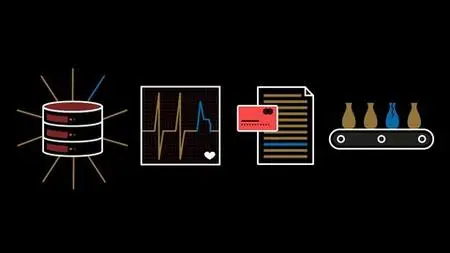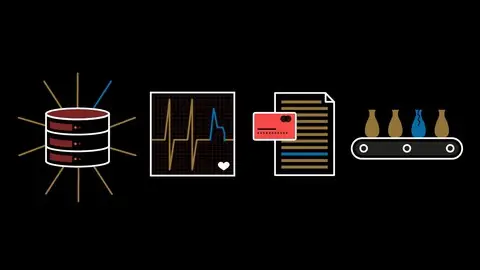Deep Learning For Anomaly Detection With Python
Published 2/2024
MP4 | Video: h264, 1920x1080 | Audio: AAC, 44.1 KHz
Language: English | Size: 232.66 MB | Duration: 1h 25m
Published 2/2024
MP4 | Video: h264, 1920x1080 | Audio: AAC, 44.1 KHz
Language: English | Size: 232.66 MB | Duration: 1h 25m
Time Series Anomaly Detection: Deep Learning Techniques for Identifying and Analyzing Anomalies in Time Series Data
What you'll learn
Understand the fundamentals of time series data and its applications in anomaly detection.
Learn how to access and load time series data, specifically from the Numenta Anomaly Benchmark dataset, using Python.
Gain proficiency in data preprocessing techniques to ensure data is ready for analysis and modeling.
Master the creation of training and testing sequences for time series data in Python.
Build a deep learning model using Python's TensorFlow and Keras libraries, specifically an autoencoder, for time series anomaly detection.
Explore hyperparameter tuning to optimize model performance and efficiency.
Develop the ability to train and evaluate a time series anomaly detection model using Python.
Understand how to set a threshold for detecting anomalies based on Mean Absolute Error (MAE) loss.
Gain practical experience in visualizing anomalies within time series data using Python's matplotlib library.
Learn how to interpret and use the results of the anomaly detection model for real-world applications.
Acquire essential Python skills for working with time series data and machine learning.
Apply knowledge gained in the course to analyze and detect anomalies in diverse time series datasets and real-world scenarios.
Requirements
Basic programming knowledge is recommended, but not mandatory. Familiarity with Python programming will be helpful.
A Google account is required to access Google Drive and Google Colab for practical exercises.
Access to a computer with a stable internet connection is necessary to access online resources and run code in the Google Colab environment.
Description
Are you ready to unlock the power of Python for advanced time series data analysis and anomaly detection? In this comprehensive course, you'll dive deep into the world of time series data and equip yourself with the skills to identify and analyze anomalies effectively. Whether you're a data enthusiast, a budding data scientist, or a professional looking to bolster your data analysis skills, this course is your gateway to becoming a proficient anomaly detection expert.What You'll Learn:Fundamentals of Time Series Data: Understand the basics of time series data, its characteristics, and real-world applications.Python Data Handling: Learn how to manipulate and preprocess time series data using Python, including libraries like NumPy and pandas.Time Series Sequences: Master the creation of sequences and windows for modeling time series data.Deep Learning for Anomaly Detection: Build and fine-tune deep learning models, specifically autoencoders, to detect anomalies in time series data.Model Evaluation: Explore techniques for training and evaluating anomaly detection models using Python's TensorFlow and Keras.Threshold Setting: Learn how to set thresholds for identifying anomalies based on Mean Absolute Error (MAE) loss.Practical Application: Apply your knowledge to real-world datasets and scenarios to detect and interpret anomalies effectively.Data Visualization: Develop skills in visualizing time series data and detected anomalies using Python's matplotlib library.Career Opportunities: Understand how your newfound expertise in anomaly detection with Python can open doors to job roles in data science, machine learning, and data analysis.Job Prospects:Upon completion of this course, you'll be well-prepared to pursue various job opportunities in the data science and machine learning fields. Potential job roles and opportunities include:Data Scientist: Join the ranks of data scientists who specialize in anomaly detection, contributing to companies' data-driven decision-making processes.Machine Learning Engineer: Apply your Python-based anomaly detection skills to create and optimize machine learning models for diverse applications.Data Analyst: Excel in the role of a data analyst who can not only work with data but also identify and communicate anomalies within datasets.IT Professional: Explore opportunities in IT departments to enhance data security and detect anomalies in system logs and performance metrics.Data-Driven Career Advancement: Leverage your anomaly detection expertise to advance your career in a variety of domains, from finance to healthcare and beyond.Unleash your potential and open the door to exciting career opportunities in the world of data science and anomaly detection with Python! This course equips you with the tools and knowledge to excel in this dynamic field.
Overview
Section 1: Fundamentals
Lecture 1 Introduction
Lecture 2 About this Project
Lecture 3 Applications
Lecture 4 Job opportunities
Lecture 5 Python, Keras, and Google Colab
Section 2: Model Building, Training and Prediction
Lecture 6 Setup Working Directory
Lecture 7 Numenta Anomaly Benchmark (NAB) dataset
Lecture 8 What is code.ipynb?
Lecture 9 Launch Code
Lecture 10 Activate GPU
Lecture 11 Mount Google Drive in a Google Colab notebook
Lecture 12 Import Python libraries
Lecture 13 Path to data files
Lecture 14 Read data from CSV file
Lecture 15 Load second dataset for testing
Lecture 16 Display first few rows of data
Lecture 17 Visualize the "small noise" dataset
Lecture 18 Visualize the "daily jumps" dataset
Lecture 19 Mean and standard deviation of the "small noise" dataset
Lecture 20 Normalize the training data from the "small noise" dataset
Lecture 21 Print the number of training samples
Lecture 22 Create sequences of data
Lecture 23 Create sequences for the training data
Lecture 24 Build an autoencoder model
Lecture 25 Trains the autoencoder model
Lecture 26 Saving the trained autoencoder model
Lecture 27 Loading a trained autoencoder model
Lecture 28 Plot training and validation loss curves
Lecture 29 Predictions on the training data
Lecture 30 Calculate Mean Absolute Error (MAE) loss
Lecture 31 Histogram of Mean Absolute Error (MAE) loss
Lecture 32 Setting threshold based on MAE loss
Lecture 33 Plotting original and predicted sequences for first training sample
Lecture 34 Normalizing the test data
Lecture 35 Visualizing normalized test data
Lecture 36 Creating sequences from normalized test data
Lecture 37 Predictions for test data
Lecture 38 Calculating MAE loss for test samples
Lecture 39 Histogram of MAE loss values calculated for test samples.
Lecture 40 Detecting anomalies in test data
Lecture 41 Finding indices of anomalous data points
Lecture 42 Plotting detected anomalies
Data scientists looking to expand their skill set in time series analysis and anomaly detection using Python.,Engineers interested in applying deep learning techniques to time series data for anomaly detection.,Data analysts who want to gain expertise in working with time series data and identifying anomalies.,Python programmers who want to explore real-world applications of Python in data analysis and anomaly detection.,Students and researchers studying data science, machine learning, or related fields who wish to enhance their practical skills.,IT professionals and analytics experts seeking to address anomaly detection challenges in their organizations.,Anyone with an interest in data analysis, time series data, and anomaly detection who wants to apply Python for practical solutions.



